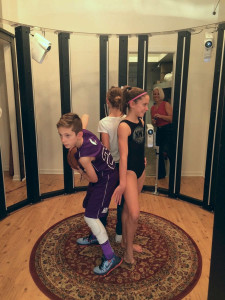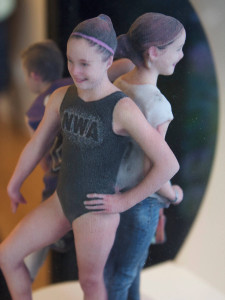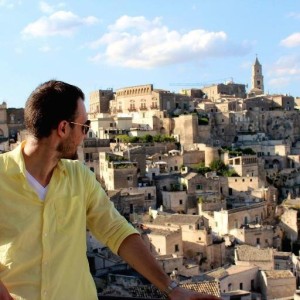
On a recent vacation to the Pacific Northwest I found myself standing downtown in the Seattle suburb of Kirkland, Washington. Being a Costco fanboy, I had come there hoping to visit the corporation’s headquarters, but the death of my phone’s battery quickly squashed these plans. So, instead of sampling prime rib and chocolate bars with Costco’s CEO, I was walking outside sans umbrella and raincoat under a sky whose ominous clouds meant you don’t dare leave home wearing suede or sunglasses.
Curiosity in such circumstances tends to lead me in the right direction, and as luck would have it, I stumbled upon what is without a doubt the most intriguing sight in downtown Kirkland: HoloDeck 3D Studios. Enticed by a window display of nearly-lifelike miniature sculptures, I entered into a world of innovation when I least expected it.
At once, I was greeted by owner-operators Dawn and Alex Morse. I asked them what HoloDeck was all about, and they responded with such sincerity that it seemed almost as though they never before had been asked that question. Apparently, the studio was dedicated to a new and revolutionary technology – the creation of nearly photo-realistic avatars and 3D-printed sculptures.*
*The name HoloDeck is inspired by Star Trek’s ‘holodeck’, a technological system that used holograms to create fictional, 3D realities.
ORIGINS
HoloDeck 3D Studios began operations in late 2015. The Morses became inspired to start the business after Dawn saw a lifelike, miniature statue of her father – a product of Artec 3D of Palo Alto – while visiting her parents. Living in the Seattle-area and having full-time careers in tech-centric industries meant that both Dawn and Alex were very familiar with the entrepreneurial opportunities provided by technological innovations such as this. But according to Alex, the real impetus for starting the business was a desire to remain active throughout life: “We don’t want to be unemployed when we retire. What would we do all those years? We want to be fun-employed!”
Originally, the Morses’ planned to target consumers at expos and special events (think cosplay at Comic Con or pet shows), but repeated requests by would-be customers to schedule appointments at a later date – either to allow for a change of clothes or so that a non-present subject could be scanned – convinced them to find a retail space. With its techie population and scenic lake vistas, they selected a site in downtown Kirkland.
PRODUCTION
The star of the studio is a circular, multi-tiered array of 89 cameras, built from Raspberry Pi computers and calibrated for 360 degrees of photo coverage. With the subject standing in the middle, the cameras simultaneously take a series of photos that are then stitched together into one, 3D, photo-realistic image using software from Berkeley-based Twindom. At this point, customers can purchase this file for use as a virtual reality or gaming avatar.
If the customer prefers to have the file printed as a statue, a computer artist first removes any irregularities within the image, such as webbing, ensuring it is water tight. Next, HoloDeck sends the file to Twindom’s printing facility, where they use a 3DSystems ProJet 660 to print the statue in powdered sandstone. Over a period of six hours, the ProJet slowly builds a statue, one 0.1 mm layer at a time. Each swipe of the printhead bonds a new layer of power to the previous one while also applying color to the edges using an HP InkJet head. Between swipes, any ceramic powder that has not been bonded is vacuumed out. The completed statue initially comes out of the printer looking like a recently-unearthed Ancient Greek sculpture, color and form obscured by sediment, but a quick airbrushing and a dip into a vat of binding superglue uncover the pigments and shape beneath. After ensuring that there have been no printing errors, Twindom ships the finished product to HoloDeck, who then present their customers with this one-of-a-kind item.


Left: Photographing clients in HoloDeck’s Kirkland, WA studio. Right: Detail of finished product.
Finished statues are often given as gifts (chances are that hard-to-buy-for relative does not already have one of these!), used to adorn wedding cakes, or meant to commemorate a special moment. Regardless of their intended purpose, the Morses take great pride in these statues, feeling that each piece is a unique work of art that makes it easier to interact with one’s memories. According to Dawn, “With every single customer, there’s a story. Whether it’s about friendship, a graduation, a wedding, or just for fun – it’s the story behind the statues that make them valuable.”
THE FUTURE
Of course, lifelike miniatures are not the only application for this technology. Several Microsoft employees have purchased 3D avatars for use with the company’s not-yet-released, personal holograph system, HoloLens. In the near future, HoloDeck’s 3D avatars will also be used by consumers shopping online, either to see how a particular article of clothing will fit them or to create perfectly-tailored shirts and pants based on their exact dimensions.
As is to be expected, the application of any new technology has its limitations. For one, while the sandstone statues are sturdy enough to withstand regular handling by their owners, they have been know to break during shipping. Likewise, the accuracy of the statues’ surface details can vary according to color and texture, with the details of hair and facial features being particularly susceptible to distortion. The Morses are confident that these issues will eventually be remedied by advances in 3D printing technology, but in the meantime, they are choosing to view these limitations in a positive light. “I always tell everyone that what I like best is that it can capture the wrinkles in your jeans, but not those in your face,” joked Dawn.
I share the Morses’ optimism, believing that the above-mentioned problems will eventually be solved – perhaps through the same sort of curiosity that inspired me to walk into the HoloDeck studio in the first place.
 About the Author
About the Author
Andrew Scott is a writer, blogger, and recovering academic who has spent the majority of the past five years studying, teaching, and traveling throughout the world. His goal is to help others live richer lives by connecting them to the exceptional travel experiences that conventional vacations so often lack. Take the first step towards life-altering travel by downloading his free ebook – ‘The Cure for the Common Trip: 9 Habits for Exceptional Travel Experiences’ – here or by exploring his website, authentictraveling.com.
